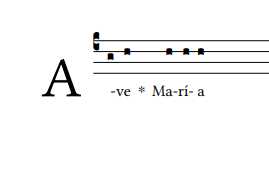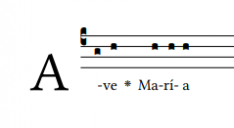GABC neophyte
-
If someone would humor my neophyte questions. I am attempting to put together a collection of chants. I could do this easily in Finale or using Meinrad fonts, but I'm attempting to learn GABC using the Illuminare score editor.
What's wrong with the following code? In particular, I'm trying to group the text under a single reciting tone. I tried using {} but that didn't seem to help. The quarter bars don't appear where I want them (after 'Son' and 'beginning'). Also, is there a way to force a line break, so the Alleluia is on it's own line?
Thus far, using the psalm tone tool, I have been able to create the Benedictus and Magnificat in Latin and English in all eight tones.
user-notes: ;
commentary: ;
annotation: ;
centering-scheme: english;
%fontsize: 12;
%spacing: vichi;
%font: GaramondPremierPro;
%width: 4.5;
%height: 11;
%%
(c4)
O(g) God,(g_) come(g) to(g) my(e) as(g)-sis-(h)tance.(g) (::) Lord,(g_) make(g) haste(e) to(d) help(e) me.(e.) (::) {Glory(gr0) to the Father, and to the Son,} (,) and(g) to(g) the(g) Ho(e)-ly(g) Spir(h)-it:(g.) (:) {as(gr0) it was in the beginning,}(,) is now, and will be for for ev-er.(e) A(d)-men.(e.) (::) Al(e)-le(g)-lu(h)-ia.(g.) (::) -
Line break at a double bar is (::Z) to break there, or (::z) to fill out to the end of the line (full justification).Thanked by 1Earl_Grey
-
The following code is producing a good .pdf for me:user-notes: ;
commentary: ;
annotation: ;
centering-scheme: english;
%fontsize: 12;
%spacing: vichi;
%font: GaramondPremierPro;
%width: 4.5;
%height: 11;
%%
(c4)
O(g) God,(g_) come(g) to(g) my(e) as(g )sis(h)tance.(g) (::) Lord,(g_) make(g) haste(e) to(dz) help(e) me.(e.) (::) Gl{o}ry to the Father, and to the Son,(gr0) (,) and(g) to(g) the(g) Ho(e)ly(g) Spir(hz)it:(g.) (:) {a}s it was in the beginning,(gr0) (,) {i}s now, and will be for ev(gr0)er.(e) A(d)men.(e.) (::z) Al(e)le(g)lu(h)ia.(g.) (::)
The nuisance (to me) of the Illuminare score editor, is that it attempts to be "what you see is what you get", but I have not usually found it successful in this regard.
Thus, once you get to a certain stage in your typesetting, you have to generate the .pdf and adjust based on those results (rather than the instant display), just as you would with the other online Gregorio tool.
Anyhow, all I have done is basically to use the curly brackets correctly, remove all hyphens (which Gregorio will insert automatically as needed), and insert line breaks by using trial and error to find out what is the maximum number of syllables that will fit on each line. To do the line breaks, you want to put in your first line break such that the line overflows by only one or two syllables: this will then show you how many syllables will fit on the line, and you can then move the line break to the correct spot, and move on to doing the same thing for line two. I use this process, because left to its own devices, Gregorio will not necessarily put as many syllables on a line as would be the maximum, and I generally want to force it to fit this maximum. The only other tweak was to put a space after the first note in "assistance", because I felt that not doing this caused the first two notes to be too close together. Notice that adding this space caused Gregorio to then add a hyphen; you get the idea.Thanked by 1Earl_Grey -
Thank you both. I was using the Illuminare editor since it can output as a image file rather than just a PDF which I would then have to convert since I'm also not working with Adobe. This is all very foreign, but I don't think Finale will ever come out with that Gregorian font I've been hoping for. I could do this all much quicker with Meinrad fonts, but this looks better, and I just need to learn it.
Not understanding the inter-workings of computer programming, how difficult would it be to develop some software that would interface more like Finale where one could see the blank score on the screen and simply drag and drop the numes from a menu and attach lyrics to them? Certainly the technology must be possible. Not sure what the development costs would be.
Another thought for those who are more experienced with GABC. Is a Word doc fine for saving/writing the codes, or would another program be preferable? I'm pretty much limited to a PC with the MS Office suite, so I'm actually creating my final project layout in Publisher. Which I know every professional designer, printer and Mac user loathes, but it's what I have at my disposal. -
A thing I noticed years ago when I was using the online renderers, and thus was saving and writing code in Word: there are multiple characters for the apostrophe, and the GABC code only uses the straight one. When I would type code in Word, it would automatically use one of the curved apostrophe characters, and this would cause Gregorio to crash when I pasted it in. Or Word would also here and there auto-incorrect one of my Latin words that it "recognized".
Good point about the image files: I had never had occasion to notice this feature of the Illuminare editor.
If you are doing anything like a book-project, is it on your radar that you could go the whole nine yards and install (or have installed, which was my case: my father did it for me) Gregorio on your own computer, and then do the whole project in TeX?
The advantage of this is that your end-result file will be entirely fonts / characters, rather than images, and thus have both perfect resolution and a quite small file size. -
I think you will find Notepad to be a good place to save your GABC code. It's such a simple word processing program that it won't interfere with your content by applying its own formatting code. You can copy and paste back and forth easily between it and the Illuminare editor.
-
O(g) God,(g_) come(g) to(g) my(e) as(g)-sis-(h)tance.(g) (::)
Hyphens belong with the previous syllable
as-(g)sis-(h)tance
to prevent extra hyphens{Glory(gr0) to the Father, and to the Son,}
Glory(gr0) to() the() Father,() and() to() the() Son,()
I use a PC with Notepad.
Use SaveAs.
Change the file suffix to (.gabc)
It will complain-warn.
Just do it. -
Attempting to generate some simple antiphons in GABC again. Planning a solemn vespers service for March 25 using the antiphons from the Antiphonale Romanum II. They don't appear on Gregorobase, so I thought I could attempt to do it myself. Already tripped up the first antiphon. I get {"error":"error: syntax error"}%%
(c4)AN(dc)ge(e)lus(f) Dó(gf)mi(d)ni(dc)(,) nun(f)ti(g)á(h)vit(g) Ma(f)rí(g)æ,(f)(;) et(fg) con(ef)cé(dewf)pit(fc)(,) de(e) Spí(dc)ri(f)tu(e) San(d)cto.(d)(::) de(ef) Spí(g)ri(f)tu(f) Sanc(fe~)to,(dc) al(d)le(fe)lú(d)ia.(d) (::) E(h) u(h) o(g) u(f) a(gh) e.(gf)(::)
Using the the illuminare score editor it looks ok (words and notes) in the preview pane. I'm also not sure how to add the * and + (flex/dagger) as well as the directive "T.P.:" for the alternate ending. I suppose I could leave that off, but was trying to match the book. Even deleting those elements I can't get the PDF to render. Must be over looking something.
My backup plan is to use Meinrad fonts, but I thought if I could figure this out I could add to the collection at Gregorobase. -
Could it be that there is a space missing after (c4) as well as before (,) (;) (,) (::) (::) ?
Try this (where I've inserted the missing spaces):%%
(c4) AN(dc)ge(e)lus(f) Dó(gf)mi(d)ni(dc) (,) nun(f)ti(g)á(h)vit(g) Ma(f)rí(g)æ,(f) (;) et(fg) con(ef)cé(dewf)pit(fc) (,) de(e) Spí(dc)ri(f)tu(e) San(d)cto.(d) (::) de(ef) Spí(g)ri(f)tu(f) Sanc(fe~)to,(dc) al(d)le(fe)lú(d)ia.(d) (::) E(h) u(h) o(g) u(f) a(gh) e.(gf) (::) -
Yes. That fixed it. Thanks! I was also able to re-insert the * and + symbols.%%
(c4) AN(dc)ge(e)lus(f) Dó(gf)mi(d)ni(dc) *(,) nun(f)ti(g)á(h)vit(g) Ma(f)rí(g)æ,(f) (;) et(fg) con(ef)cé(dewf)pit(fc) +(,) de(e) Spí(dc)ri(f)tu(e) San(d)cto.(d) (::) + de(ef) Spí(g)ri(f)tu(f) Sanc(fe~)to,(dc) al(d)le(fe)lú(d)ia.(d) (::) E(h) u(h) o(g) u(f) a(gh) e.(gf) (::)
How do I enter text that is not attached to a nume? Namely the indication "T.P.:" for the alternate ending?
Also, where do I enter the mode and final (If) so that it appears above the first letter? -
By the way, there are two star-characters available in Gregorio. The common asterisk produces a six-pointed star, while the special code <v>\greheightstar</v> yields an eight-pointed character. Here are examples:



 ave-sample-1.png269 x 169 - 5K
ave-sample-1.png269 x 169 - 5K
 ave-sample-2.png239 x 131 - 4KThanked by 1Earl_Grey
ave-sample-2.png239 x 131 - 4KThanked by 1Earl_Grey -
Also, where do I enter the mode and final (If) so that it appears above the first letter?
In the preamble, add a line:annotation: If;Thanked by 1Earl_Grey -
In more recent versions of Gregorio, it's
mode: 1.f;
(the number is converted to a Roman numeral automatically)
Welcome to the MusicaSacra Forum!
To participate in the discussions on Catholic church music, sign in or register as a forum member, The forum is a project of the Church Music Association of America.
Categories
- All Discussions21,059
- General Music Discussion8,196
- Job Openings191
- Management of Music Programs850
- Choral Matters532
- Church Documents and Rubrics524
- CMAA Notes300
- Events712
- For Newcomers: Read First26
- Sacred Polyphony546
- Hymnody871
- Gregorian Chant: General2,694
- ↳ Graduale Romanum and Liber Usualis367
- ↳ Graduale Simplex60
- ↳ Semiology63
- Vernacular Plainsong695
- Anglican Use and Anglican Chant69
- Organ, Other Instruments and Repertoire434
- New Composition/Works in Progress1,287
- Recordings229
- Music for Hispanic Ministry159
- Music Education: Children211
- Music Education: General222
- News Items245
- Positions Wanted2
- General Discussion: Catholicism738
- Amusements176
- General Discussion1,033
- Opinions117





